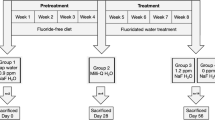Abstract
Melatonin is the main product of the pineal gland, and trace metals play a critical role in growth and development. The purpose of this study was to assess the serum zinc (Zn) and magnesium (Mg) levels in pinealec-tomized chicks and their possible interactions with the development of spinal deformity. Chicks were divided into two equal groups: unoperated controls (group M) and pinealectomized chicks (group N). Pinealectomies were performed at the age of 3 d. After 8 wk, serum Zn and Mg levels of 10 animals from each group were measured by spectrophotometric assay. The results of analyses were compared using the Mann-Whitney U-test. The correlation between serum Zn and Mg levels were assessed by Spearman's correlation. In this study, it was obvious that the serum Zn levels in group N were significantly lower than those in group M (2.8±0.10 vs 4.2±0.14 ppm; p<0.0005). In contrast, Mg levels in group N was high compared with the values in group M, although there was no significant difference (17.8±0.69 vs 15.7±0.85 ppm; p>0.05). In pinealectomized animals, serum Zn levels declined significantly while serum Mg levels increased, albeit insignificantly. Thus, there was a moderately positive but not statistically significant correlation between Mg and Zn levels in unoperated controls (r=0.273, p>0.05), whereas there was a negative but not statistically significant correlation between Zn and Mg levels in pinealectomized chicks (r=−0.115, p>0.05). In addition, the serum Mg to serum Zn ratio was significantly higher in group N than in the group M control (6.39±0.32 vs 3.75±0.22, respectively; p<0.001). From the results of the current study, it is clear that surgical pinealectomy in newly hatched Hybro Broiler chicks has a significant effect on serum Zn level. However, the serum Mg did not change significantly. Because serum Mg is not a good indicator of Mg status in chicks, it is speculated that other tissues, such as muscle or spine, might productively be explored as a more sensitive Mg biomarker for this model. The present study provides experimental evidence that serum trace metal levels might be affected in pinealectomized animals because of the lack of its main neurohormone melatonin.
Similar content being viewed by others
References
K. Bagnall, V. J. Raso, M. Moreau, J. Mahood, X. Wang, and J. Zhao, The effects of melatonin therapy on the development of scoliosis after pinealectomy in the chicken, J. Bone Joint Surg. 81-A, 191–199 (1999).
M. Beuerlein, J. Wilson, M. Moreau, et al., The critical stage of pinealectomy surgery after which scoliosis is produced in young chickens, Spine 26, 237–240 (2001).
M. Machida, Cause of idiopathic scoliosis, Spine 24, 2576–2583 (1999).
M. Turgut, M. Ç. Yenisey, A. Uysal, M. Bozkurt, and M. E. Yurtseven, The effects of pineal gland transplantation on the production of spinal deformity and serum melatonin level following pinealectomy in the chicken, Eur. Spine J. 12, 487–494 (2003).
X. Wang, M. Moreau, J. Raso, et al., Changes in serum melatonin levels in response to pinealectomy in the chicken and its correlation with development of scoliosis, Spine 23, 2377–2381 (1998).
E. J. Underwood, Trace Elements in Human and Animal Nutrition, Academic, New York (1977).
G. Cikim, H. Canatan, M. F. Gursu, F. Gulcu, G. Baydas, and A. E. Kilicoglu, Levels of zinc and lipid peroxiadation in acute coronary syndrome, Biol. Trace Element Res. 96, 61–68 (2003).
S. Michelle, P. Alain, and B. Françoise, Minerals, trace elements and related biological variables in athlets and during physical activity, Clin. Chim. Acta 321, 1–11 (2001)
G. Öztürk, Ş. Coşkun, D. Erbaş, and E. Hasanoglu, Effect of melatonin treatment on serum and tissue zinc levels in rats, J. Trace Elements Exp. Med. 15, 1–8 (2002).
C. Wallwork, Zinc and central nervous system, Prog. Food Nutr. Sci. 11, 203–247 (1987).
S. Yazar, E. Kiliç, and R. Saraymen, Changes of total content of magnesium and zinc status in patients with chronic toxoplasmosis, Biol. Trace Element Res. 92, 11–16 (2003).
B. Poeggeler, R. J. Reiter, D. X. Tan, L. D. Chen, and L. C. Manchester, Melatonin, hydroxyl radical-mediated oxidative damage, and aging: a hypothesis J. Pineal Res. 14, 151–168 (1993).
A. S. King, and J. McLelland, Birds: Their Structure and Function, Bailliere Tindall, London, pp. 210–211 (1984).
R. J. Reiter, Pharmacological actions of melatonin in oxygen radical pathophysiology, Life Sci., 60, 2255–2271 (1997).
Q. I. Wan, and S. F. Pang, Segmental, colonal and subcellular distribution, of 2-(1251)Iodo melatonin binding sites in the chicken spinal cord, Neurosci. Lett. 180, 253–256 (1994).
R. J. Maughan, Role of micronutrients in sport and physical activity, Br. Med. Bull., 55, 683–690 (1999).
P. P. N. Lee, and S. F. Pang, Identification and characterization of melatonin binding sites in the gastrointestinal tract of duct, Life Sci. 50, 117–125 (1992).
M. T. Martin, F. Azpiroz, and J. R. Malagelada, Melatonin and the gastrointestinal tract, Therapie 53, 453–458 (1998).
S. C. Cunnane, D. F. Horrobin, M. S. Manku, and M. Oka, Alteration of tissue zinc distribution and biochemical analysis of serum following pinealectomy in the rat, Endocr. Res. Commun. 6, 311–319 (1979).
J. Limson, T. Nyokong, and S. Daya, The interaction of melatonin and its precursors with aluminium, cadmium, copper, iron, lead, and zinc: an adsorptive voltammetric study, J. Pineal Res. 24, 15–21 (1998).
C. P. Mahoney, F. A. Alster, and L. B. J. Carew, Growth, thyroid function, and serum macromineral levels in magnesium-deficient chicks, Poult. Sci. 71, 1669–1679 (1992).
M. Turgut, S. Kaplan, A. T. Turgut, et al., Morphological, stereological and radiological changes in pinealectomized chicken cervical vertebrae, J. Pineal Res. 39, 392–399 (2005).
Author information
Authors and Affiliations
Rights and permissions
About this article
Cite this article
Turgut, M., Yenisey, Ç., Bozkurt, M. et al. Analysis of zinc and magnesium levels in pinealectomized chicks. Biol Trace Elem Res 113, 67–75 (2006). https://doi.org/10.1385/BTER:113:1:67
Received:
Accepted:
Issue Date:
DOI: https://doi.org/10.1385/BTER:113:1:67




